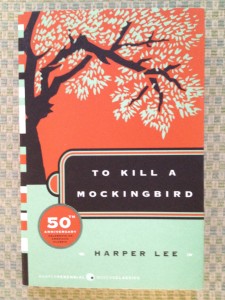
Unless you’re hibernating, you’ve heard the bombshell news that Harper Lee, beloved author of To Kill a Mockingbird, will publish her long-thought-disappeared manuscript, Go Set a Watchman. It’s an understatement that readers and critics alike are weighing in on this event. The tectonic plates underlying the United States (and beyond) will shift on July 14th, 2015.
Up to this point, Harper Lee has always been thought of as a one-book author, but oh, what a wondrous book. The fact that she only published the one doesn’t outweigh the fact that over 40 million copies of TKAMB have been circulating within the global library since 1960. At age 88, Ms. Lee is no James Patterson.
Yes, he’s a wonderful writer of psychological thrillers and young-adult fiction. But Mr. Patterson has transformed himself into a factory-like cottage industry that somehow rankles my bookish sensibilities. And Harper Lee (well, at least until mid-July) is not alone. There are other authors who injected a narrative into one published book and then (due to unforeseen circumstances) called it a “novel” career.
Whether you become a Go Set a Watchman lover or hater (because haters ARE gonna hate, once Jean Louise Finch makes her next printed appearance), here are other one-book authors for your consideration:
Tomorrow Wasn’t Another Day for Scarlett O’Hara after Margaret Mitchell’s Death in 1949: The story of how Scarlett O’Hara Hamilton Kennedy Butler (original first name: Pansy!) came to be is a fabulous one, firmly entrenched in Deep South lore and Margaret Mitchell’s broken bones.
Ms. Mitchell started out as a privileged Atlanta gal, born in 1900. As a young child, she was mesmerized by porch-told tales of “The War Between the States” while sitting on many a Confederate veteran’s lap. She was a rebellious tomboy (and then Jazz Age flapper) who evolved into a local reporter for The Atlanta Journal.
But after hurting her ankle in a car accident in 1926 (this turns out to be tremendous foreshadowing), Mitchell became a semi-invalid. Her second husband, John Marsh, schlepped so many books from the local library for her to read that he eventually put a stop to it by suggesting she write her own book.
And that’s what she did–for approximately the next 10 years! But Peggy Mitchell never had any grand illusions of printed or cinematic fame. She also never intended to write a sequel for Scarlett O’Hara and Rhett Butler.
She died at age 49–yes, another car accident. A novella of hers kept under wraps since 1916, Lost Laysen, was published posthumously in 1996. But technically, Margaret Mitchell remains a one-mega-hit novelist. Fiddle-dee-dee!
Poet Sylvia Plath Had Delayed Success as the Author of The Bell Jar: Ms. Plath’s story is an extremely sad one: ongoing depression from an early age. A marriage to famous poet Ted Hughes that nearly eclipsed her own fearless poetry collections. (Give either The Colossus and Other Poems or Ariel a try, why don’t you?)
And of course, there is her carefully plotted suicide by gas oven at age 30 in 1963.
Sylvia’s only novel, The Bell Jar, is a semi-autobiographical book loosely based on her time at Smith College and her 1953 internship with Mademoiselle magazine. I think Sylvia’s book puts Susanna Kaysen’s 1993 memoir, Girl, Interrupted, to shame, but I’m a focus group of one.
The Bell Jar came out in January 1963, just a few weeks before her February 11th suicide. It was originally published under the pseudonym Victoria Lucas (because that’s how much Sylvia’s mother wanted to block the book’s publication).
If poetry isn’t your thing, the 288 pages of Plath’s first (and last) book will provide you with an intimate glimpse into young-and-gifted depression.
Black Beauty Resulted from an Ankle-Twisting Accident That Spurred a Love of Horses: Okay, ladies (and a few gentlemen): How many of you read Black Beauty when you were in elementary school? Did you ever wonder why there were no other books written by its author? Here’s the story…
From age 14, and until her death in 1877, Anna Sewell lived a very secluded British life of limited mobility (due to a serious accident that injured both her ankles). She spent many years loving horses and advocating for their humane treatment.
But she didn’t start writing her only novel (it was intended for horse lovers, not children) until she was 51 years old. And by the way–Anna Sewell’s mother was an author of children’s books!
She initially dictated the story to her mother, no youngster herself. Eventually Anna scratched out all the bits and pieces of her book, which Mom then transcribed for her. The book was completed in 1877, but Anna Sewell died of hepatitis five months later that same year.
When next you’re looking for a great book to give to a young animal lover, don’t hesitate to buy Black Beauty for that special girl or boy.
A Brooding Bronte Known As Ellis Bell Wrote One Hell of a Wuthering Novel: Emily Bronte was a sickly young woman predisposed to the family’s medical history. Her publishing name was Ellis Bell–women weren’t much respected as writers in 19th-century England.
Some consider Emily Bronte’s literary achievement overshadowed by that of sisters Charlotte (Jane Eyre, Vilette) and Anne (Agnes Grey, The Tenant of Wildfell Hall). I personally think her Wuthering Heights, published in 1847, the most brooding and romantic of all the Bronte novels.
Only a year later in 1848, she succumbed to the dreaded tuberculosis (known as consumption back then) that claimed most of her family members. Alas, we’ll never know if Emily Bronte had another story brewing within her to surpass the ill-fated love between Cathy and Heathcliff.
The Wildest Thing Oscar Wrote Was The Picture of Dorian Gray: Oscar Fingal O’Flahertie Wills Wilde was an Irish playwright and poetic bad boy whom late-19th-century literary critics loved to hate.
He wrote one book (actually, more of a novella) in his lifetime–The Picture of Dorian Gray. But sweet mother of invention, what a Faustian-tinged tale of trading your soul and conscience for immortal youth.
The story was first revealed in 1890 to an unsuspecting readership in serial format via the July issue of Lippincott’s Monthly Magazine. The full novella became available for purchase the following year; what a moralistic commotion it caused.
The book’s plot follows a man (Dorian Gray) who doesn’t age. Instead, his freaky-deaky painted portrait absorbs his dirty deeds and guilty conscience in a most horrifying way.
Trust me: This book is so much better than that Intro to Psychology course you suffered through your first year of college! Don’t fear the flamboyant Wilde’s bad reputation–his solo novel/novella should be on your reading bucket list.
I realize this post is starting to gather moss. Here are a few more fabulous one-hit wonders for your reading consideration:
Invisible Man by Ralph Ellison (If you’ve never read Ellison’s classic 20th century novel about racial alienation, you should. It won the National Book Award for Fiction in 1953. A fire consumed the draft of Mr. Ellison’s next manuscript in 1967. Tragic!)
Raintree County by Ross Lockridge, Jr. (Most people know of the movie starring Elizabeth Taylor and Montgomery Clift. Lockridge’s is one of the darkest, saddest one-hit-wonder trajectories. He suffered from depression, committing suicide a few months after his book was published in 1948.)
The Catcher in the Rye by J. D. Salinger (What an invasive arc Mr. Salinger’s life took after his iconic Catcher was published in 1951. Yes, he did pen a collection of short stories in 1953 that fared well, and his novella Franny and Zooey came out in 1961. But nothing he wrote after Catcher ever surpassed the tale of Holden Caulfield’s tremulous nervous breakdown.)
Doctor Zhivago by Boris Pasternak (The Russian commissars did not take kindly to this story of polygamous love bordered by harsh bookends: the Russian Revolution of 1905 and World War II. Doctor Zhivago was smuggled out of Mother Russia in 1957. Pasternak, a beloved poet in his country, won the 1958 Nobel Prize for Literature. But under intense pressure from his higher-up comrades, he declined the honor…)
Do you think less of an author who writes only one book in his or her lifetime? If so, why is that? What other “one-book authors” not mentioned in this post are deserving of your commentary?
And finally: How do you really feel about Harper Lee’s Go Set a Watchman being readied for publication this summer? Will you buy it, rent it, or forget it altogether? For those of you who can’t resist Scout Finch’s continuing narrative as a grown-up visiting 1950s Maycomb, Alabama, here’s the only link you need…
(I will now crawl back into my hibernation hidey-hole until 10 consecutive days of above-40-degree weather smile upon southern New Jersey!)
Lori Shapiro is the owner of By All Writes LLC, a business-to-business (B2B) writing, editing, and research company in Marlton, New Jersey. She revels in shielding her clients from the pain of writing their own print or web marketing and educational copy. Please call Lori Shapiro at 856-810-9764 or email By All Writes LLC at lori@byallwrites.biz for a no-obligation project quote today!










Wow, Lori, quite a list. Thanks for researching this and sharing. I love to hear other writers’ stories.
Hi Greg,
A very belated thank-you for reading and enjoying this post. I believe February froze my brain (and fingers)most cruelly!
Regards,
Lori
I have utmost respect for one-book authors. Writing a book is a massive (and often risky) undertaking. It’s more impressive to write one killer novel (no matter what the circumstances are) than to churn out two or more lackluster books a year. Thank you for pointing out a couple of winners.
Hello Linda,
Another belated thank-you for reading my blog post regarding one-book authors. I too have respect for such writers–one killer novel in my lifetime would be a grand accomplishment!
Regards,
Lori
I’m with Linda on this – I think no less of an author who writes “only” one book in his or her lifetime. Perhaps they have only one story in them; it doesn’t diminish the value of the wonderful story they’ve told! Or perhaps circumstance only affords them a single opportunity, as in the case of MY favorite one-hit-wonder from your list, Emily Bronte.
Hi Bonny,
Yep, I’m with you and Linda–one story written/told epically beats multiple books from an author that are merely “meh.” As for Emily Bronte: She’s smiling down upon us all (whilst walking those heavenly moors)…
Regards,
Lori